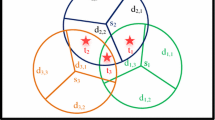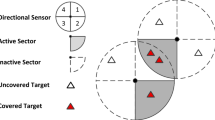Abstract
Wireless sensor networks have become one of the prominent and persuasive methods for surveillance of inaccessible physical areas and are employed in innumerable applications in various fields. Some applications may require directional sensor nodes in contrast to the conventional omnidirectional ones. Many challenges emerge during deployment of such sensor networks especially in terms of energy constraints. These sensor nodes are furnished with non-rechargeable energy sources which may lead to inefficiency in the network within a very short span of time. Conserving energy of the sensor nodes by organizing the sensor nodes into cover sets and actuating them one after the other, while ensuring maintenance of the complete coverage of all targets, is one of the common approaches to extend the network lifetime. This paper addresses Q-coverage problem of directional sensor networks in which each target is required to be covered by different number of sensor nodes for effective surveillance and Q-coverage constraints are considered while segregating the sensor nodes operating in different sensing directions to a different cover sets. An approach based on genetic algorithm is proposed to find an ideal solution to the directional Q-coverage problem and the simulation results confirm that the network lifetime is prolonged.






Similar content being viewed by others
References
Arampatzis T., Lygeros J., & Manesis S. (2005). A survey of applications of wireless sensors and wireless sensor networks. IEEE International Symposium on Mediterrean Conference on Control and Automation Intelligent Control, 719–724.
Waltenegus, D. W., & Poellabauer, C. (2010). Fundamentals of wireless sensor networks: theory and practice. London: Wiley.
Arivudainambi D., Balaji S., Deepika S. & Swetha S. (2015). Connected coverage in wireless sensor networks using genetic algorithm. IEEE Workshop on Computational Intelligence: Theories, Applications and Future Directions, 1–6.
Arivudainambi, D., & Balaji, S. (2016). Improved memetic algorithm for energy efficient sensor scheduling with adjustable sensing range. Wireless Personal Communication, 95(2), 1737–1758.
Arivudainambi D., Sreekanth G. & Balaji S. (2016). Energy efficient sensor scheduling for target coverage in wireless sensor network, Wireless Communications, Networking and Applications, LNEE, vol. 348.
Vijayaraju, P., Sripathy, B., Arivudainambi, D., & Balaji, S. (2017). Hybrid Memetic algorithm with two dimensional discrete haar wavelet transform for optimal sensor placement. IEEE Sensors Journal, 17(7), 2267–2278.
Sasa Slijepcevic, & Miodrag Potkonjak (2001). Power efficient organization of wireless sensor networks. IEEE International Conference on Communications, 472–476.
Kumar, S., Lai, T. H., & Arora, A. (2007). Barrier coverage with wireless sensors. Wireless Networks, 13, 817–834.
Mihaela Cardei, My T. Thai, Ying shu Li. & Weili Wu (2005). Energy-efficient target coverage in wireless sensor networks. IEEE 24th Annual Joint Conference of the IEEE Computer and Communications Societies, pp. 1976–1984.
Mihaela Cardei & Ding-Zhu Du. (2005). Improving wireless sensor network lifetime through power aware organization. Wireless Networks, 11(3), 333–340.
Wu-chi Feng, Ed Kaiser, Wu Chang Feng, & Mikael Le Baillif (2005). Scalable low-power video sensor networking technologies. ACM Transactions on Multimedia Computing, Communications, and Applications 1(2), 151-167.
Mohammad Rahimi, Rick Bae, Obimdinachi I Iroezi, Juan C Garcia, Jay Warrior, Deborah Estrin, & Mani Srivastava (2005). Cyclops: in situ image sensing and interpretation in wireless sensor networks, Third International Conference on Embedded Networked Sensor Systems, pp. 192—204.
Ai, J., Alhussein, A., & Abouzeid,. (2006). Coverage by directional sensors in randomly deployed wireless sensor networks. Journal of Combinatorial Optimization, 11(1), 21–41.
YanliCai, W. L., Li, M., & Li, X.-Y. (2009). Energy efficient target-oriented scheduling in directional sensor networks. IEEE Transactions on Computer, 58(9), 1259–1274.
Wang, J., Niu, C., & Shen, R. (2009). Priority-based target coverage in directional sensor networks using a genetic algorithm. Computer Mathametics Applications., 57(11), 1915–1922.
Rossi, A., Singh, A., & Sevaux, M. (2013). Lifetime maximization in wireless directional sensor network. European Journal of Operational Research, 231(1), 229–241.
YanliCai, Wei Lou, Minglu Li, & Xiang-Yang Li (2007). Target-oriented scheduling in directional sensor networks, ICCC, pp. 1550–1558.
Jian Wang, Changyong Niu & Ruimin Shen (2007). Randomized approach for target coverage scheduling in directional sensor network. International Conference on Embedded Software and Systems, pp. 379–390.
Singh, A., & Rossi, A. (2013). A genetic algorithm based exact approach for lifetime maximization of directional sensor networks. Ad Hoc Network, 11(3), 1006–1021.
Gil, J.-M., & Han, Y.-H. (2010). A target coverage scheduling scheme based on genetic algorithms in directional sensor networks. Sensors, 11(2), 1888–1906.
Yu Gu, Hengchang Liu, & Baohua Zhao (2007). Target coverage with QoS requirements in wireless sensor networks. IEEE ICIPC, pp. 35–38.
Singh, A., Rossi, A., & Sevaux, M. (2013). Matheuristic approaches for Q-coverage problem versions in wireless sensor networks. Engineering Optimization, 45(5), 609–626.
Manju Chaudhary, & Arun K. Pujari (2009). Q-coverage problem in wireless sensor networks. DCN, pp. 325–330.
Li, D., Liu, H., Xianling, Lu., Chen, W., & Hongwei, Du. (2012). Target Q-Coverage problem with bounded service delay in directional sensor networks. International Journal of Distributed Sensor. https://doi.org/10.1155/2012/386093
Singh, A., & Rossi, A. (2015). Group scheduling problems in directional sensor networks. Engineering Optimization, 47(12), 1651–1669.
Huiqiang Yang, Deying Li, & Hong Chen (2010). Coverage quality based target-oriented scheduling in directional sensor networks. IEEE ICC, pp. 1–5.
Arivudainambi D., Balaji S., & Rekha D (2014). Improved memetic algorithm for energy efficient target coverage in wireless sensor networks. IEEE ICNSC, pp. 261–266.
Chih-Chung Lai, Chuan-Kang Ting, & Ren-Song Ko (2007). An effective genetic algorithm to improve wireless sensor network lifetime for large-scale surveillance applications. IEEE CEC, pp. 3531–3538.
Ting, C.-K., & Liao, C.-C. (2010). A memetic algorithm for extending wireless sensor network lifetime. Information Sciences, 180(24), 4818–4833.
Funding
Authors received no Grants from any funding agency in the public, commercial, or not-for-profit sectors.
Author information
Authors and Affiliations
Corresponding author
Ethics declarations
Conflict of interest
The authors declare that they have no conflicts of interest.
Data Availability
Data sharing not applicable to this article as no datasets were generated or analyzed during the current study.
Code Availability
The code that is used this study are available from the corresponding author, upon reasonable request.
Additional information
Publisher's Note
Springer Nature remains neutral with regard to jurisdictional claims in published maps and institutional affiliations.
Rights and permissions
About this article
Cite this article
Anitha, M., Somasundaram, P., Balaji, S. et al. Optimal Scheduling of Directional Sensors with QoS Constraints to Enhance the Lifetime. Wireless Pers Commun 124, 741–761 (2022). https://doi.org/10.1007/s11277-021-09381-4
Accepted:
Published:
Issue Date:
DOI: https://doi.org/10.1007/s11277-021-09381-4




